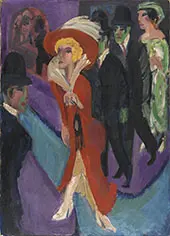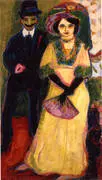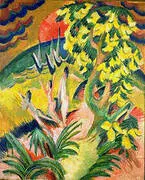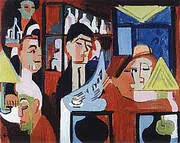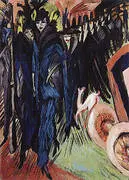Ernst Kirchner Oil Painting Reproductions
Ernst Kirchner replica paintings on Canvas for sale
Ernst Kirchner Paintings: An Artistic Biography
Ernst Ludwig Kirchner paintings are some of the most compelling examples of German Expressionism art. As a founding member of Die Brücke artists’ group, Kirchner revolutionized artistic production in Germany.
Today, we present some of the most famous Kirchner paintings. We’ll also explore the personal stories and inspiration behind these iconic artworks.
Where was Ernst Kirchner born?
Born on 6 May 1880, Ernst Ludwig Kirchner spent his early life in the town of Aschaffenburg in northwestern Bavaria. The family often moved, though, as Kirchner’s father searched for work.
They eventually settled in Chemnitz (a city in Saxony, in the east of Germany), where Kirchner attended secondary school.
Kirchner later enrolled in the Königliche Technische Hochschule in Dresden. He learned the basics of drawing, art history, and architectural design here.
During this time, Kirchner also met Fritz Bleyl. The young men discussed art and philosophy, particularly their admiration for the growing German Expressionist movement.
What was Ernst Kirchner’s art movement?
Kirchner completed his degree in 1905. In the same year, he also founded Die Brücke artists’ group. He is best known for instigating this movement.
Known as “The Bridge” in English, it brought many leading German Expressionist painters together.
Die Brücke’s four founding members were Ernst Kirchner, Fritz Bleyl, Karl Schmidt-Rottluff, and Erich Heckel. From this point onwards, Kirchner threw himself into artistic production. He painted many of his creative companions in An Artist’s Group (c.1926-27).
The group proved fundamental to the development of German Expressionism art.
What inspired Ernst Ludwig Kirchner?
Kirchner admired German artists such as Albrecht Dürer and Lucas Cranach the Elder. He also took inspiration from folk art, such as woodcut prints and the symbolist art of Edvard Munch. Vincent van Gogh’s post-impressionist work was also particularly stimulating.
Combining these inspirations of traditional portraiture and “naïve” folk art, Kircher created his unique style. His artwork used simplified forms and bright colors, often creating unsettling, sexually charged scenes.
As a result, Ernst Ludwig Kirchner paintings are notable for their expressive psychological qualities and erotic overtones. His brave use of color and movement defines work from his mid-career, such as Kirchner Street Berlin (1913).
The painting is an exciting and aspirational yet profoundly unnerving creation. The Berlin women’s mask-like faces represent the danger and sensuality underpinning modern society.
What did Ernst Ludwig Kirchner reject?
As a member of Die Brücke artist’s group, Kirchner rejected the academic rules of painting. Instead, he sought a new form of artistic creation to “bridge” old and new.
Kirchner’s work appears similar to Les Fauves (led by Henri Matisse). This group also used bold colors and simplified forms. Despite this, Fauvist paintings often maintained a sense of joy and optimism. The jagged outlines and emotional intensity of Kirchner paintings show his different approach.
Kirchner’s nude artworks develop themes of sexual aggression and desire. These themes are most notable in paintings such as Girl under a Japanese Parasol (1909) and Nude Viewed from the Back (1912).
Who influenced Kirchner’s art?
Kirchner gained inspiration from Die Brücke artists group, as well as a whole host of earlier painters. These inspirations included influences as diverse as Albrecht Dürer, Edvard Munch, and Vincent van Gogh.
The group moved to Berlin in 1911, where Kirchner’s career took off. He produced many woodcut artworks, book and poetry illustrations, and engravings.
In 1914 however, the First World War started. Kirchner volunteered for active service early on. Unfortunately, despite this initial enthusiasm, he experienced a mental breakdown. As a result, commanding officers discharged Kirchner in 1915.
Kirchner’s mental deterioration appears in works such as Self Portrait as a Soldier (1915) and the later Self Portrait as a Sick Man (1918).
After this, Kirchner moved to Switzerland and increasingly focused on landscape paintings. These later works (Winter Moon Landscape) tell a story of humanity at peace with nature, undisturbed by war and the modern machine age.
Why is Ernst Ludwig Kirchner important?
Ernst Ludwig Kirchner is important for his contributions to German Expressionism and Die Brücke. In addition, Kirchner paintings represented an entirely new and imaginative approach to art.
Despite his earlier success, Kirchner’s mental health declined with the rise of the Nazi party from the 1930s onwards. As a result, the Nazi party declared his art “degenerate” and destroyed many famous Kirchner paintings.
He never recovered from this disappointment and committed suicide aged 58. Kirchner died on 15 June 1937.
What is German Expressionism?
Given Kirchner’s importance for German Expressionism, it’s worthwhile exploring this movement in more detail.
German Expressionist art emerged in the early twentieth century. It prioritized artists’ inner thoughts and emotions over realistic representation.
There were two groups of German Expressionist painters. The first group was Die Brücke, led by Kirchner, Bleyl, Schmidt-Rottluff, and Heckel. Following this, Wassily Kandinsky and Franz Marc founded Der Blaue Reiter group.
Although there were many similarities between the two movements, Der Blaue Reiter’s artists were a more informal association. They also focused more on color theory.
What are the characteristics of German expressionism art?
German Expressionism art uses simple shapes, compositions, and bright (often contrasting) colors. In addition, German Expressionist paintings often use rapid brushwork laid spontaneously.
Consequently, brushstrokes are visible rather than carefully blended. The resulting artworks (wonderfully exemplified by Ernst Ludwig Kirchner) were emotional, raw, and confrontational.
What are the main themes of German Expressionism?
German Expressionism was an offshoot of the broader Expressionist movement, which took hold across Europe.
Expressionist artists distorted reality (and traditional artistic rules) to depict their inner emotions. The color was often highly intense, with textured paint and free brushwork. As such, German Expressionist paintings followed the main themes of Expressionism.
Specifically, German artists also dealt with class, cosmopolitan culture, and the relationship between individuals and the state. Their clashing colors and shards of jagged forms reflected the profound unease of German society in the early twentieth century.
Ernst Ludwig Kirchner Paintings: German Expressionism Art
If you love the energy and dynamism of Ludwig Kirchner art, explore our extensive collection of German Expressionist paintings.
You’ll discover museum-quality replica artworks from Wassily Kandinsky, Franz Marc, Ernst Ludwig Kirchner, and more.
Cannot Find What You Are Looking For?
Reproduction Gallery Information
Customer Service
(Send Us A Message)
Tel: (302) 513 3464


